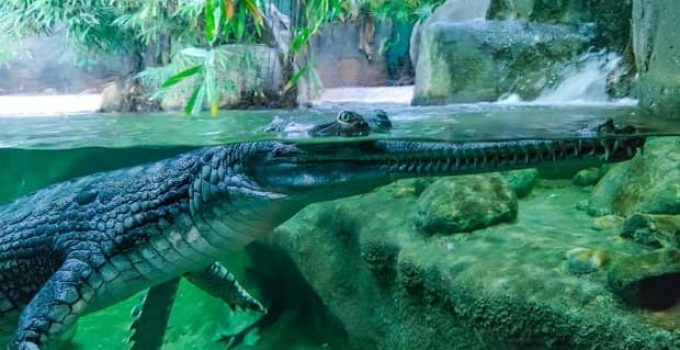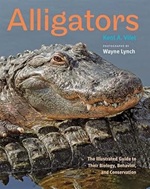Author: Gabrielle Marks
Reviewed: 5/28/2025
Where Do Crocodiles Live?
Answer at a Glance: Crocodiles are less cold-tolerant than alligators, preferring warm tropical regions. [1] Most species can be found near the equator in Africa, Asia, North America, South America, and Australia. This is a look at the “true crocodiles,” those that belong to the Crocodylidae family.
You can find the global distribution of all three crocodilian families (Alligatoridae, Crocodylidae, and Gavialidae) at “A Geographical Look at Crocodilians.” [2]
Dig Deeper
- African Crocodiles
- Asian Crocodiles
- Australian Crocodiles
- North American Crocodiles
- South American Crocodiles
- References
African Crocodiles
Depending on the source, Africa is home to six crocodile species: the Nile Crocodile, the West African Crocodile, the (Western and Central) African Slender-Snouted Crocodile, and the African Dwarf Crocodile/Osborn’s Dwarf Crocodile. Some organizations have yet to recognize two species as independent.
- African Slender-snouted Crocodile (Crocodylus cataphractus) can be found along small streams and rivers in central and south Africa (Angola, Benin, Burkina Faso, Cameroon, Central African Republic, Chad, Congo, Cote d’Ivoire, Democratic Republic of Congo, Equatorial Guinea, Gabon, Gambia, Ghana, Guinea, Guinea Bissau, Liberia, Mali, Mauritania, Nigeria, Senegal, Sierra Leone, Tanzania, Togo, and Zambia). [3] In 2018, researchers found that there are actually two distinct species: the Western African Slender-Snouted Crocodile (M. cataphractus) and the Central African Slender-Snouted Crocodile (M. leptorhynchus). [4]
- Nile Crocodile (Crocodylus niloticus) is found across Africa, primarily in the central, eastern, and southern regions of the continent. ( Angola, Benin, Botswana, Burkina Faso, Burundi, Cameroon, Central African Republic, Chad, Congo, Cote d’Ivoire, Democratic Republic of Congo, Egypt, Eritrea, Ethiopia, Equatorial Guinea, Gabon, Gambia, Ghana, Guinea, Guinea Bissau, Kenya, Liberia, Madagascar, Malawi, Mali, Mauritania, Mozambique, Namibia, Niger, Nigeria, Rwanda, Senegal, Sierra Leone, Somalia, South Africa, Sudan, Swaziland, Tanzania, Togo, Uganda, Zambia, Zimbabwe.) Although this species is capable of living in saltwater, it is mainly found in freshwater areas. [5]
- West African Crocodile (Crocodylus suchus) can be found in the dry interior of western Africa. [6]
- African Dwarf Crocodile (Osteolaemus teraspis) can be found across tropical regions of Sub-Saharan West Africa and Central Africa (Angola, Benin, Burkina Faso, Cameroon, Central African Republic, Congo, Cote d’Ivoire, Democratic Republic of Congo, Equatorial Guinea, Gabon, Gambia, Ghana, Guinea, Guinea-Bissau, Liberia, Mali, Nigeria, Senegal, Sierra Leone, Togo). [7]
- Osborn’s Dwarf Crocodile (O. tetraspis) is nearly identical to the African Dwarf Crocodile, with minor differences in the skull. Although a 2009 genetic study identified it as a separate species, some organizations, such as the International Union for Conservation of Nature and Natural Resources (IUCN), list it as a subspecies of the African Dwarf Crocodile. The species extends from southeastern Cameroon and southwestern Central African Republic southward to the Republic of the Congo, the Democratic Republic of the Congo, western Uganda, and northwestern Angola. [7]
Asian Crocodiles
Asia is home to five crocodile species: the Mugger Crocodile, the Siamese Crocodile, the Saltwater Crocodile, the Philippine Crocodile, and the New Guinea Crocodile.
- Philippine Crocodile (Crocodylus mindorensis) is found in small numbers in the Philippines, primarily in Mindanao and the Sulu Archipelago. [8]
- New Guinea Freshwater Crocodile (Crocodylus novaeguineae) is a freshwater species found in New Guinea and Indonesia. [9]
- Mugger Crocodile (Crocodylus palustris) is a freshwater species with the broadest range of Asian crocodiles. This species can be found in India and Sri Lanka. They can also be found in Iran, Pakistan, Nepal, and Bangladesh, though very few are still in existence. The Mugger crocodile is the only crocodile species found in Pakistan and Iran. [10]
- Siamese Crocodile (Crocodylus siamensis) is a small freshwater species that was once prevalent in Thailand, the Indochinese region, and parts of Indonesia. Today, the only known wild ones can be found at the Bung Boraphet Reservoir in Nakhon Sawan province, Thailand. [11]
- Saltwater Crocodile (Crocodylus porosus), also known as the Estuarine crocodile, is the largest of all crocodilians. On the Asian continent, it can be found in saltwater and brackish habitats, ranging from India’s east coast through Southeast Asia. [12]
Australian Crocodiles
Australia is home to two species of crocodiles: the Saltwater Crocodile and the Freshwater Crocodile.
- Saltwater Crocodile (Crocodylus porosus) is found in saltwater and brackish habitats in northern Australia. [13]
- Australian Freshwater Crocodile (Crocodylus johnstoni), found only in Australia, is commonly known as the Johnstone’s River Crocodile. This species can be found in Western Australia, Northern Territory, and Queensland. [14]
North American Crocodiles
North America is home to three crocodile species: the American Crocodile, Morelet’s Crocodile, and the Cuban Crocodile.
- American Crocodile (Crocodylus acutus) can be found on both the Atlantic and Pacific coasts of southern Mexica, Central America, northern South America, and the Caribbean islands, including Cuba, Jamaica, and Hispaniola. In North America, this species can only be found on the southern tip of Florida. [15]
- Morelet’s Crocodile (Crocodylus moreletii) can be found in freshwater lagoons, swamps, and streams from Belize and Guatemala north through the Yucatan Peninsula into northeastern Mexico. [16]
- Cuban Crocodile (Crocodylus rhombifer) is a species of crocodile found in Cuba, inhabiting swampy areas. [17]
South American Crocodiles
South America is home to many crocodilians, but only one crocodile species: The Orinoco Crocodile.
- Orinoco Crocodile (Crocodylus intermedius) is found in the Orinoco River in Columbia and Venezuela. [18]
References
- [1] Mazzotti, F. J., Cherkiss, M. S., Parry, M., Beauchamp, J., Rochford, M., Smith, B., Hart, K., & Brandt, L. A. (2016). Large reptiles and cold temperatures: Do extreme cold spells set distributional limits for tropical reptiles in Florida? Ecosphere, 7(8), e01439. https://doi.org/10.1002/ecs2.1439
- [2] Crocodile Specialist Group – “Classification of Living Crocodilians.”
- [3][7][9][11] Crocodile Specialist Group – “Crocodiles.”
- [4] Shirley, M.H., Carr, A.N., Nestler, J.H., Vliet, K.A. & Brochu, C.A. (2018) Systematic revision of the living African Slender-snouted Crocodiles (Mecistops Gray, 1844). Zootaxa, 4504 (2), 151–193. https://doi.org/10.11646/zootaxa.4504.2.1
- [5] Fergusson, R.A. (2010). Nile Crocodile Crocodylus niloticus. Pp. 84-89 in Crocodiles. Status Survey and Conservation Action Plan. Third Edition, ed. by S.C. Manolis and C. Stevenson. Crocodile Specialist Group: Darwin
- [6] Brittanica.com “Western African Crocodile.”
- [7] Brittanica.com “Osborn’s Dwarf Crocodile.”
- [8] Van Weerd, M. (2010). Philippine Crocodile Crocodylus mindorensis. Pp. 71-78 in Crocodiles. Status Survey and Conservation Action Plan. Third Edition, ed. by S.C. Manolis and C. Stevenson. Crocodile Specialist Group: Darwin.
- [10] Brittanica.com – “Mugger Crocodiles.”
- [12][13] National Geographic – “Saltwater Crocodile.”
- [14] Australian Musem – “Freshwater Crocodile.”
- [15] John B. Thorbjarnarson. University of Florida – Department of Wildlife and Range Sciences – “Ecology of the American Crocodile, Crocodylus Acutus.”
- [16] Platt, S.G., L. Sigler, and T.R. Rainwater. 2010. Morelet’s Crocodile Crocodylus moreletii. Pages 79-83 in S.C. Magnolis and S. Stevenson, eds. Crocodiles. Status survey and conservation action plan. Third edition. Crocodile Specialist Group. Darwin, Australia.
- [17] Britannica.com “Cuban Crocodile.”
- [18] Seijas, A.E., Antelo, R., Thorbjarnarson, J.B. and Ardila Robayo, M.C. (2010). Orinoco Crocodile Crocodylusintermedius. Pp. 59-65 in Crocodiles. Status Survey and Conservation Action Plan. Third Edition, ed. by S.C. Manolis and C. Stevenson. Crocodile Specialist Group: Darwin.
Related Products
Alligators: The Illustrated Guide to Their Biology, Behavior, and Conservation Hardcover – Illustrated
by Kent A. Vliet (Author), Wayne Lynch (Photographer)
In this fascinating account, richly illustrated with more than 150 photographs from award-winning wildlife photographer Wayne Lynch, expert zoologist Kent A. Vliet introduces readers to the biology, ecology, and natural history of the American alligator.

